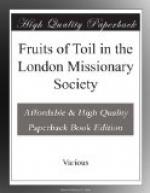it was between 1820 and the death of Radama in 1828,
that the Mission Schools, the printing press, and
instruction in the industrial arts, laid deep the
foundation of that education and enlightenment which
have so greatly benefited the population at large.
And it was during those brief years the seeds were
sown of that true spiritual life and christian principle
which produced a native christian church, and enabled
it, nourished by Divine grace, to bear the bitter persecution
of twenty-six years. No fiercer resolve to maintain
an old national idolatry has been witnessed in modern
days, than that from which this persecution sprang.
It was steadfast, uncompromising, and unrelenting.
Maintained throughout the lifetime of the persecutors,
it was especially bitter and violent on three occasions.
a. In July, 1837, when the profession
of christianity was forbidden, when all christian
worship was stopped, and all books were ordered to
be given up, our first martyr, a true christian woman,
RASALAMA, was speared. RAFARALAHY followed her,
a year after. In 1840 nine were speared; many
hundreds were made slaves; two hundred at least became
fugitives. In 1842 the persecution extended to
Vonizongo, and, of five brethren who suffered,
two were executed, and three were poisoned. By
this time seventeen had lost their lives: and
both christian and heathen had learned the great lesson,
that a true faith in Christ enables its followers
without fear to meet all penalties for conscience’
sake, and even with gladness to lay down life itself.
b. The second great trial, intended to
be more severe, fell on the scattered church with
the year 1849. Nineteen confessors were seized,
but they answered their persecutors bravely, and looked
on death without fear. Fourteen were thrown over
the lofty precipice; the four nobles sang hymns amid
the burning flames, while the bright rainbow arched
the heavens and inspired them with more than mortal
joy. Nineteen hundred of their faithful companions
were fined; a hundred were flogged; many others were
enslaved, and made “to serve with rigour”
in public works, in felling timber and hewing stone.
But still was it true of these “children of
Israel,” “the more they oppressed them,
the more they multiplied and grew.” c.
The third persecution was more bitter and resolute
still. In July, 1857, when mutiny and massacre
were at their height in Upper India, fourteen were
stoned to death at FIADANA, followed by seven others;
and sixty-six were loaded with heavy chains.
The church was still more scattered; but many of the
leading brethren were securely hidden, and “had
their lives given them as a prey.”
In 1861 the church obtained its long-lost liberty, and was permitted again to profess its belief in open day. Rich in faith, steadfast in principle, it only needed a wider range of Scripture knowledge and some little guidance in its public affairs. Singularly free from the admixture of foreign elements in its constitution, it had pastors and teachers; the brethren were accustomed to edify one another, and were zealous for the spread of the truth among their fellow-countrymen.




